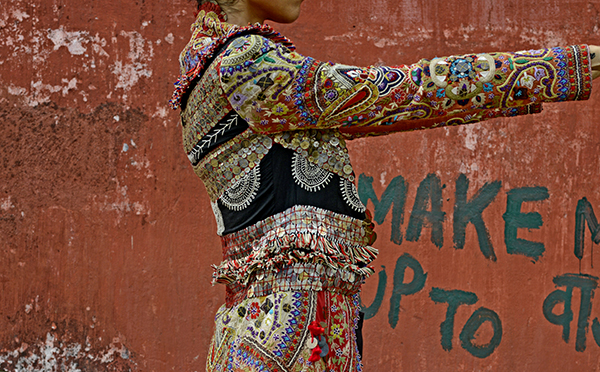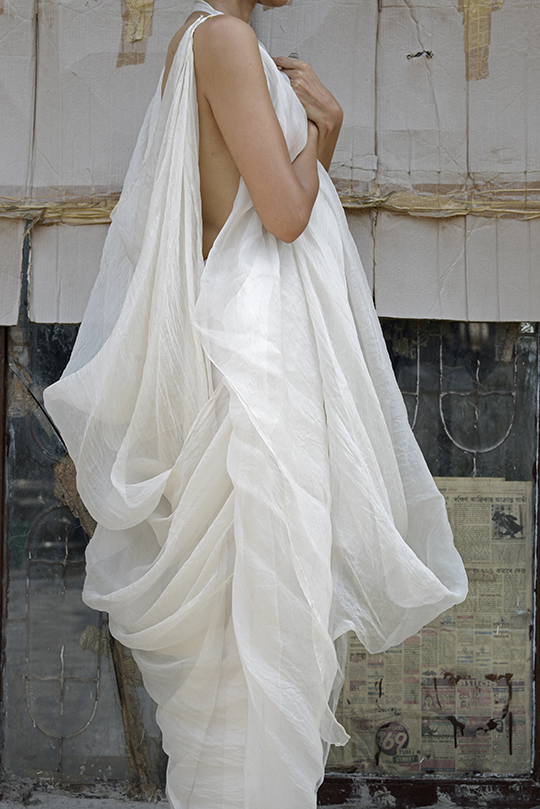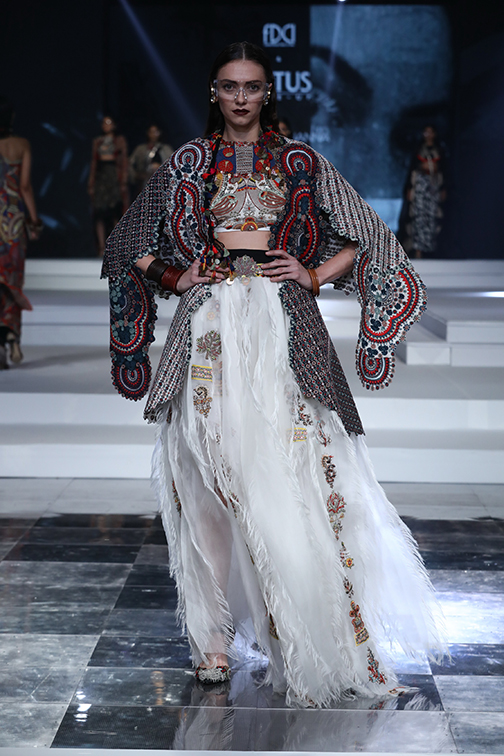Timeless Textiles: Exploring India’s Influence on Western Fashion

Writer Taylor Transtrum
Photography Courtesy of Phoenix Art Museum and designer Anamika Khanna
[dropcap]I[/dropcap]ndia has always held a special place in Helen Jean’s heart.
“A love of this region has long been a professional curiosity of mine,” says Jean, Jacquie Dorrance Curator of Fashion Design at Phoenix Art Museum. “When I was approached by the museum to offer a proposal for a new exhibition, this seemed like the perfect opportunity to explore the culture in and around the Sikh community. Broadening that to India just made sense.”
From streetwear to couture, Phoenix Art Museum’s latest exhibition — India: Fashion’s Muse — explores a love affair centuries in the making. Featuring garments from the 19th to the 21st centuries, the exhibition takes a deep dive into the ways Indian dress, aesthetic, artwork and tradition have inspired Western fashion designers past and present.
One of the iconic images the exhibition looks at is the paisley pattern, which was originally a Persian pattern that traveled along the Silk Road to India and beyond. It has since become one of the most beloved patterns around the world — across cultures and dress traditions — and one that we still find in our homes today.



“We also look at animal imagery — the peacock, the tiger, the elephant — and how that has been used in accessories and incredible couture beaded gowns from the 1920s,” Jean says.
With ensembles from nine of India’s 28 states, India: Fashion’s Muse also explores some of the most iconic dress traditions of the country.
“These different ensembles are valuable because they communicate so much about people from these different regions,” Jean says. “The color of the sari; the type of weave; if it’s an embroidered design or woven design; if it’s dyed; if it’s tie-dyed or ikat — all of those things communicate where [in] India this person is from.”
One of the most recognizable of these garments is the sari. Made of 4 to 9 yards of fabric, this versatile garment can be draped dozens of ways — each of which tells its own unique story.
“The sari is all about balance, poise and grace all day long,” Jean says. “It’s just the most incredible thing.”
A television in the exhibition’s gallery displays “The Sari Series,” a digital anthology documenting India’s regional sari drapes. Award-winning artist Sarah Singh’s short film “I Thought I Was Dreaming” is also on-screen in the gallery. It features India’s first supermodel Kirat Young and is based on the 1982 India-inspired collection by Yves Saint Laurent.
In order to accurately represent each sari, Jean enlisted the help of the local Indian community.
“We wanted [the exhibition] to be as authentic, clear and correct as it could possibly be,” she says. “This was not a story we could tell by ourselves. I was in an incredibly fortunate position to be able to find people to help tell this story, to help collect the objects and to help give them the platform to put the pieces together.”
In addition to looking at traditional Indian saris, India: Fashion’s Muse explores Western interpretations of the dynamic garment. Among these pieces are examples from the Chanel Pre-Fall 2012 collection.
There is also a robin’s egg blue and silver lame sari from the 1960s by Givenchy, which is similar to another ensemble that was featured in the film “Breakfast at Tiffany’s.” In the film, Audrey Hepburn’s character Holly Golightly enters a party with what is essentially a sari draped over her shoulder.
“Even though she’s just draped it comically in this moment of the film, that’s one of the first times that we see the sari in Hollywood and it just explodes,” Jean says. “It’s such an incredible silhouette.”
The curator adds that the sari is “a lifetime garment.”
“You grow up learning how to drape it, how to wear it, how to move in it, how to be in it,” she explains. “It becomes a part of your identity and the Western versions are celebrations of that.”



Jean’s favorite Western interpretation of the sari in the exhibition is a fuschia gown by French couture designer Pierre Balmain.
“The theme of the exhibition is represented by this dress,” Jean says. “It’s an incredible silk sari that has been repurposed in the hands of this incredible French designer into a 1970s-style cocktail gown. This is the dress that I chose for the title wall, for the invitation [and] for all of the accents. It’s all inspired by this dress.”
The curator adds that Alexander McQueen’s 2008 peacock dress — located at the top of the museum’s stairs — is another key piece of the exhibition.
“It was commissioned by the Fashion Institute of Design and Merchandising and it’s something to be celebrated,” she says. “The amount of work that went into making the dress, preserving the dress and showing the dress is really a testament to the value we hold to fashion as art and the very important story that clothing tells about us and our experiences.”
Closing out the exhibition are eight couture ensembles by Indian fashion designer Anamika Khanna.
“Each of these pieces is hand-embroidered and hand-beaded,” Jean says. “They are exquisite, multilayered and they are each a celebration of the many different rich textile and embroidery traditions around India.”
Khanna will be celebrating the U.S. premiere of her newest collection with a May 3 fashion show at Phoenix Art Museum — just one of several events that are being held in conjunction with the exhibition.
“[India: Fashion’s Muse] presents a lot of incredible opportunities to see what’s happening in fashion in a part of the world that has and will continue to guide fashion,” Jean says. “I urge visitors to open their hearts when they come to the exhibition. I want them to come and learn to be better borrowers and celebrators of culture.”
India: Fashion’s Muse
Through June 21 | See website for hours | Phoenix Art Museum | 1625 N. Central Ave., Phoenix | $18+ | 602-257-1880 | phxart.org

